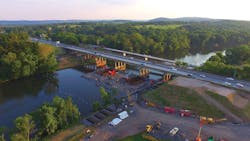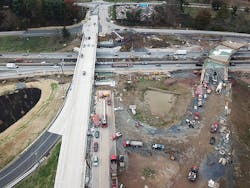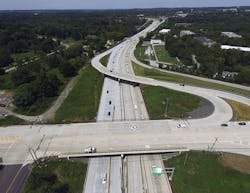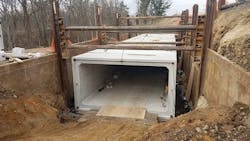Reconstruction of river bridge built in the mid-1960s will help sustain the remarkable growth of the Philadelphia suburbs
Growth has transformed King of Prussia and Pottstown—two Philadelphia suburbs—into two of the largest economic centers in Pennsylvania and the greater Mid-Atlantic region.
U.S. Route 422 and the bridge at Valley Forge over the Schuylkill River carries 113,000 vehicles per day and links these suburbs to Philadelphia. Severe congestion on the expressway and bridge led the Pennsylvania Department of Transportation (PennDOT) to complete a major reconstruction. The recently completed, $97.6 million reconstruction project is one of what is known as the U.S. 422 River Crossing Complex Projects, which are geared to improve multimodal travel and reduce congestion along U.S. 422 between the PA Route 23 and PA Route 363 interchanges.
The reconstruction project provides modern wider bridges to improve travel and carry U.S. 422 motorists over the Schuylkill River, Norfolk Southern Railroad, South Trooper Road, an Upper Merion Township Trail, and the Schuylkill River Trail in Montgomery County, as a part of the Schuylkill River Crossing Complex Improvement Program. The focal point of this program was the replacement and expansion of the U.S. 422 Schuylkill River Bridge and the widening and reconstruction of 1 mile of U.S. 422 between the PA 23 and PA 363 interchanges. Urban Engineers Inc. served as the prime design consultant for this 10-year project and provided environmental studies, preliminary engineering, final design, and construction consultation.
Design Approach
The design of the U.S. 422 Schuylkill River Bridge was continuously refined with consideration to multiple construction packages being developed simultaneously. Each package included integrated overlapping elements needing to be coordinated to function in interim and final conditions. For example, design and construction overlapped between the U.S. 422 Schuylkill River Bridge and the adjacent Sullivan’s Bridge, a multiuse trail bridge, located 120 ft upstream. U.S. 422 Schuylkill River Bridge pier locations were based on the most economical span layout with consideration given to the original pier locations. As a result, Sullivan’s Bridge pier locations were refined to align with the Schuylkill River Bridge pier locations. The causeway construction sequence of Sullivan’s Bridge was also incorporated into the Schuylkill River Bridge package to ensure that the Schuylkill River was not completely obstructed during construction. These integrated overlapping elements ensured no impact to the 100-year floodplain and minimal disruption to recreational boaters.
The PA 23 interchange reconfiguration will allow for a new “gateway” area for Valley Forge National Historical Park. To support this reconfiguration, interim improvements included the elimination of the U.S. 422 WB/PA 23 WB off-ramp and the modification of a PA 23 intersection. A new U.S. 422 EB/PA 23 (flyover) off-ramp was also designed and constructed in preparation for the future 2,400-ft-long North Gulph Road realignment. In addition to providing an opportunity for a new VFNHP gateway, the completed interchange reconfiguration will also serve as a buffer between U.S. 422 and Valley Forge National Historical Park.
As part of this interchange reconfiguration, a state-of-the-art underground storm water management vault was designed and installed in the ramp side hill, behind the sound barrier within PennDOT’s original right-of-way and between the flyover ramp and the park.
New specifications were adopted during design to increase the concrete strength upper limit for prestressed concrete beam members from 8 ksi to 10 ksi. This material improvement translated into the use of shallower bridge beam depths and the elimination of one beam line (in each direction), affording a refinement to roadway/bridge profiles that resulted in a cost savings and reduction in utility, right-of-way, and environmental impacts.
Public Perception
The design improves the capacity, operations, and access of U.S. 422 and the PA 23 and PA 363 interchanges. These improvements also help relieve diversionary regional traffic on the local roadways, including roads within Valley Forge National Historical Park, and protect the surrounding communities and park resources. The project is consistent with planned growth and has a positive public image. Additional features include a section of an Upper Merion Township trail; a sound barrier adjacent to the park; a bridge barrier that minimizes visual obstruction of the Schuylkill River; and numerous architectural surface treatments and aesthetic color coatings on structures.
The bridge approach roadway widening required identifying and relocating cremated remains of several individuals within the Crane Family Sanctuary at the First Presbyterian Church of Port Kennedy cemetery. Archaeologists and landscape architects consulted with surviving family descendants and church leadership to complete the relocation before the adjacent roadway excavation work commenced. During construction, advance notice was required prior to any earth disturbance in this area, so that excavation activities could be monitored by an archeologist should any indication of unidentified remains be encountered.
Local Considerations
Through substantial reduction in congestion, the project will improve the region’s economic viability. The sound barrier will provide noise levels at or below current levels at Valley Forge National Historical Park and maintain tranquility for park visitors. By improving and extending the serviceability of U.S. 422, the project increases the value of the state’s transportation infrastructure investment.
The project was not visually intrusive to the surrounding environment. Temporary construction impacts to the Schuylkill River and recreational boaters were mitigated by implementing an Aids to Navigation Plan. Temporarily disturbed river bank areas were restored with a native riparian seed mix, and steep sections of riverbank were restored using live willow stakes for greater bank stability.
Habitat Protection
It was determined that the U.S. 422 Schuylkill River Bridge construction may cause impacts to the locally threatened red-bellied turtle and the nationally threatened, locally endangered northern long-eared bat. As such, mitigation plans were incorporated into the construction contract documents. Considerations for the turtles included enforcement of an in-stream restriction period, installation of turtle exclusion fencing, restoration of temporarily disturbed streambank areas, creation and enhancement of a nesting habitat, and placement of a nesting soil mixture. To avoid potential impacts to roosting northern long-eared bats, a tree harvesting restriction period between April 1 and October 30 was specified.
Unexpectedly, during a period of project shutdown due to COVID-19, a peregrine falcon nest was spotted on one of the Schuylkill River Bridge piers. This required coordination with the Pennsylvania Game Commission to ensure work did not impact the nesting habits of this locally threatened and protected species.
Complexity
Given the limited river crossings in this area, the potential to reroute traffic—113,000 VPD—via detour or allow motorists to select alternate routes was limited. Therefore, a complex four-stage maintenance and protection of traffic plan with multiple subphases was employed to ensure adequate capacity throughout the project.
The new U.S. 422 EB/PA 23 (flyover) off-ramp included a unique, two-span, 193-ft x 44-ft curved steel girder bridge over U.S. 422. A detailed maintenance and protection of traffic plan to maintain two lanes of U.S. 422 traffic in each direction during construction of a median pier was developed. Due to the structure’s 409-ft radius, unique design loading, challenging deck geometry, and complex rebar detailing needed to be addressed.
This section of the Schuylkill River is located within a detailed FEMA study area with a defined floodway; 100-year water surface elevation increases were not allowed without requiring a FEMA map revision. The Schuylkill River is also a perennial stream and navigable waterway, a state-designated scenic river, and a warm water fishery and migratory fishery. Due to these classifications, causeways were not permitted to extend across the entire width of the river. Urban Engineers identified these constraints early in the project and addressed them during design and constructability review. The team’s constructability engineers helped the design team size the causeway and develop the schematic layout of cranes for beam erection. The constructability review also considered crane load determination, crane selection, and support of excavation limits. Identifying the causeway requirements during preliminary engineering was key to obtaining railroad, right-of-way, and environmental clearances and meeting final design and let-date schedules.
Construction challenges included a tight timeline on design-build intelligent transportation system (ITS) elements, a jacked casing under U.S. 422 with narrow tolerances, and difficult beam delivery and placement logistics. The tight ITS timeline required close monitoring of every detail from submissions through testing and acceptance. This ITS work included the need to splice portions of the 144-strand fiber “backbone” from the PennDOT Traffic Management Center that services more than 600 ITS devices throughout the region. The jacked casing for the 30-in. drainage pipe required precise placement due to its limited elevation tolerances. Additionally, 70 precast (Superload) 157-ft-long beams had to be carefully coordinated since delivery times were restricted to daytime, on-site staging areas were limited, and route weight and clearance postings existed.
The project team included: AECOM Technical Services Inc. provided archaeological testing, cemetery/burial site investigations, cremated remains relocation/sanctuary landscape restoration design, and red-bellied turtle impact assessment and mitigation design. Structures design support services were provided by WSP USA Inc. Survey and geotechnical investigations were provided by AWK Consulting Engineers Inc. Environmental studies, ITS, traffic, and geotechnical support services were provided by Gannett Fleming Inc. Red-bellied turtle mitigation construction support services were provide by Rummel, Klepper & Kahl LLP. J.D. Eckman Inc. served as the contractor, while JBC Associates Inc. served as the construction manager/construction inspector.
This project was substantially completed in the fall of 2020. Its success and quality can be measured by construction work orders. Construction is approximately 98% complete and the current work order authorizations amount to -0.002% of the contractor’s bid price. The engineer’s estimate was within 5% of the winning bid.






